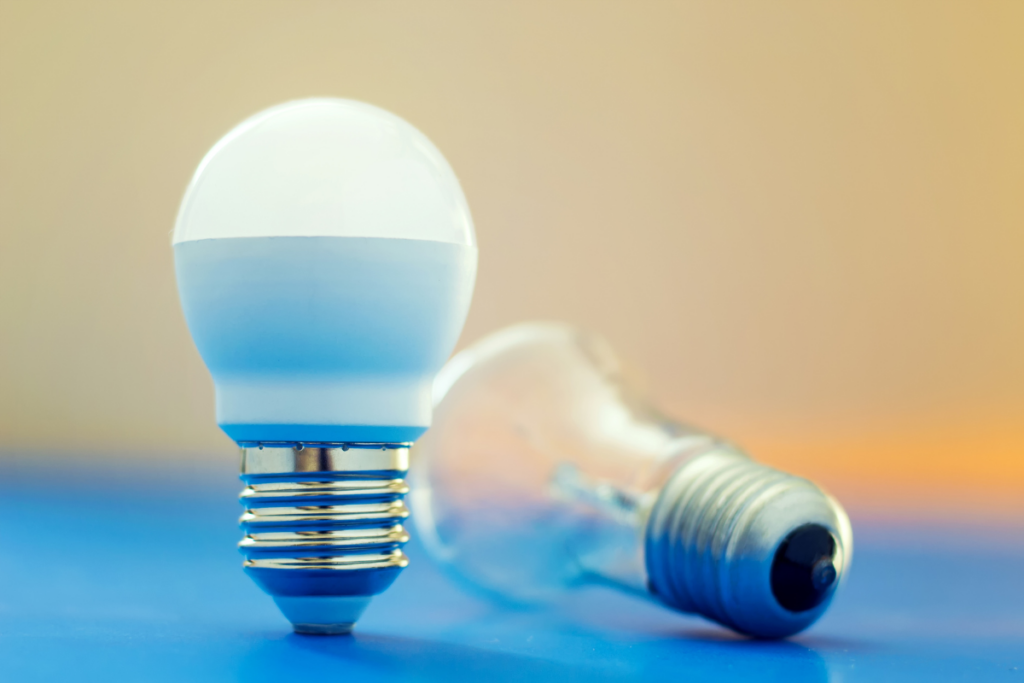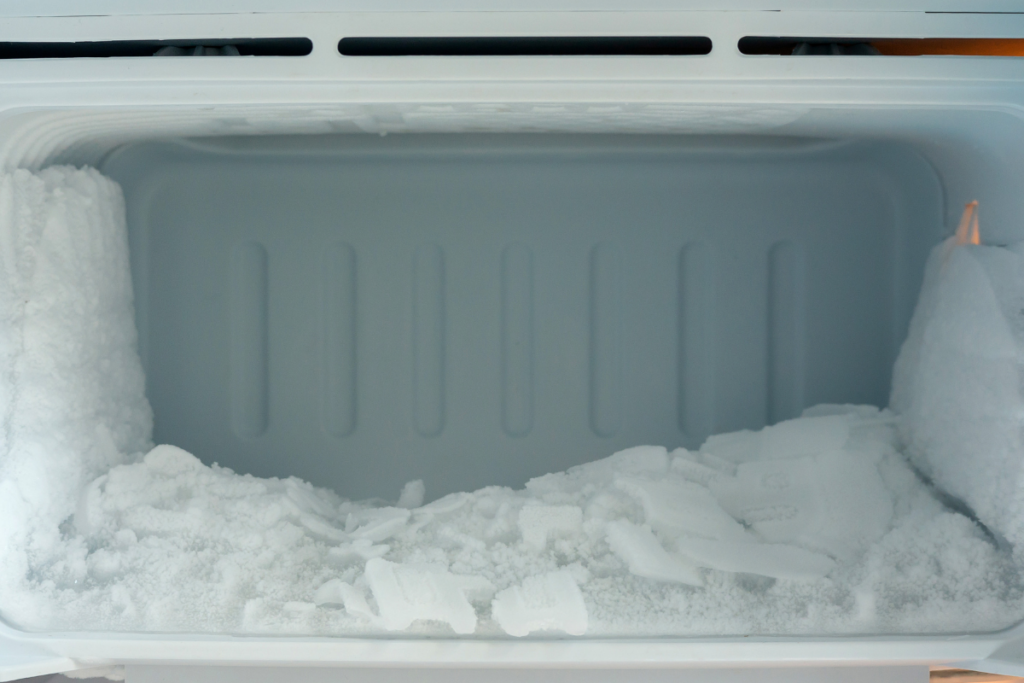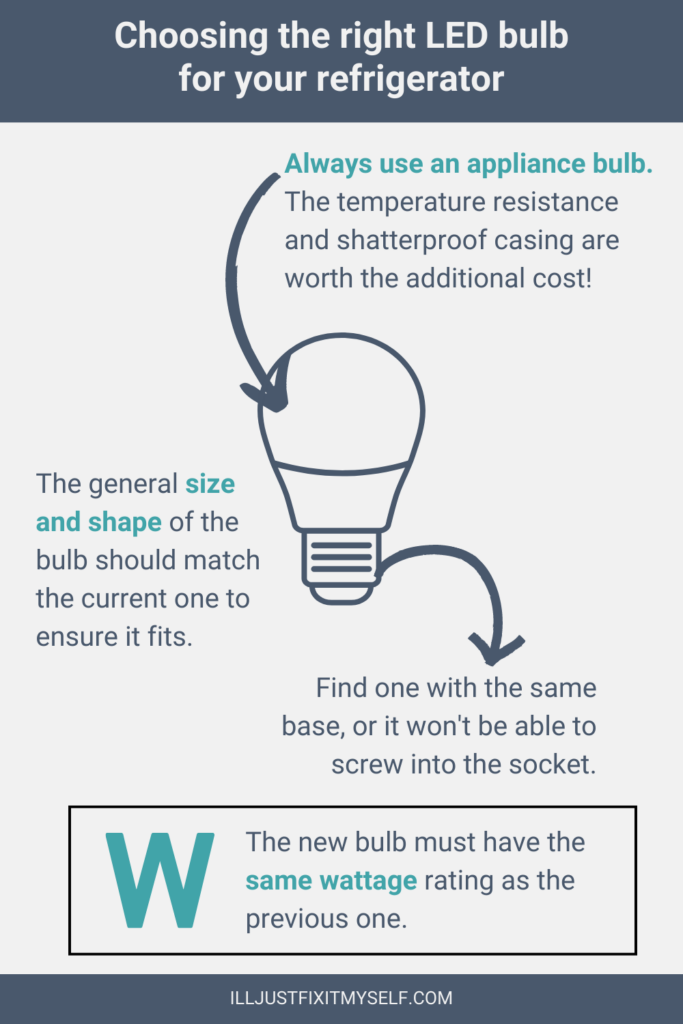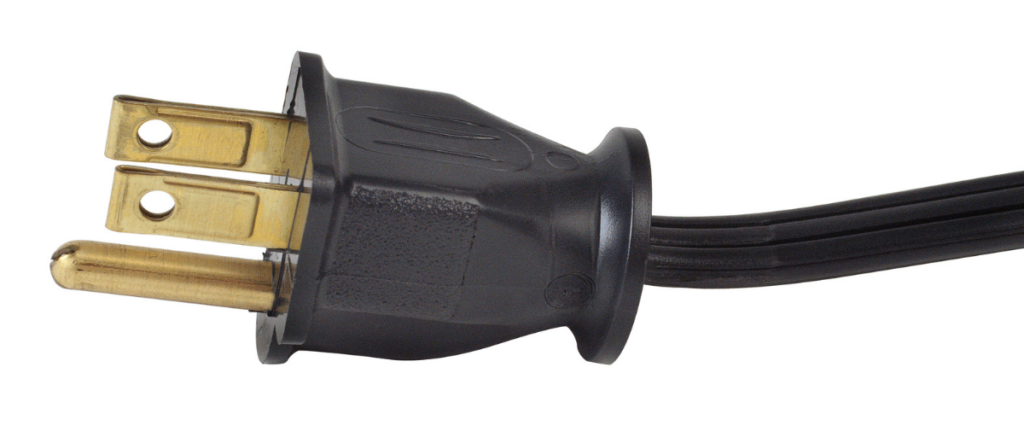Can LED Bulbs Be Used in Refrigerators? [What about the Freezer?]
As a kid, you probably stood in front of the refrigerator door and tried to figure out if the light stayed on all the time. These days, you probably know that it goes off when the door is closed, but what happens if it doesn’t come back on? When it comes time to screw in the replacement, can LED lights be used in refrigerators?
Most refrigerator light bulbs can be easily replaced with an LED bulb of the same wattage that has a compatible base. Typically, refrigerators use a 40W A15 appliance bulb, which is smaller than a standard bulb and better suited for cool environments. Built-in LED string lights will need to be replaced by an authorized technician.
Keep reading to learn why replacing your burned out refrigerator light with an LED bulb may help save you money. I’ve also got some top tips on the best ways to make the switch!
Can you use LED lights in the refrigerator?
LED lights are becoming more and more popular in the United States. In fact, according to the 2020 Residential Energy Consumption Survey, 47% of U.S. households now report using LED lights for most – if not all – of their indoor lighting. But can you use them in your refrigerator?
LED bulbs can be used to replace incandescent bulbs in most refrigerators. Ensure that the replacement has the same base size, bulb shape, and wattage as the existing bulb. Check your owner’s manual for the exact specifications.

Like incandescent bulbs, LED bulbs come in a wide variety of sizes, shapes, and colors. When replacing the light bulb in your refrigerator, it’s important to ensure that you choose one that matches the light the manufacturer supplied.
Try to avoid removing the light bulb until you’re ready to replace the bulb. Due to the nature of the fridge’s light – namely that it’s specifically designed to be on whenever the door is open – you’ll need to unplug the refrigerator to turn it off.
Consult the owner’s manual to find out exactly what type of light bulb your appliance needs. Appliance light bulbs will often typically list which popular models they will work with, but it’s better to use that information as a reassurance, not a guarantee.
Should you use an LED or incandescent bulb in the fridge?
Your main question when it comes time to replace a light bulb probably revolves around wattage or even if you want a “warm” light or a “cool” light in the room, but that’s not all you have to worry about when it comes to your refrigerator bulb.
When deciding whether or not to use an LED bulb in your refrigerator, the question really comes down to compatibility. LED bulbs are more energy-efficient than incandescent bulbs and the cost savings – LED bulbs only use about 10% the power – more than makes up for the difference in price.
| Metric | LED Bulb | Incandescent Bulb |
|---|---|---|
| Cost | about $6 | about $5 |
| Average life span | 50,000 hours | 1,200 hours |
| Appropriate for a cool environment | yes, the cool air may actually help it last longer | produces heat, which may be counterproductive |
| Energy efficient | yes | no |
| Color | bright white | warm, yellowish |
| Compatibility | likely yes – consult owner’s manual | likely yes – consult owner’s manual |
LED lights are slightly more expensive than incandescent bulbs, but they are significantly more energy efficient. In the case of your refrigerator, this means you’ll be spending less every time you open the fridge door.
Even better, they don’t produce heat, meaning you also won’t run the compressor more to offset the heat of the light – and that means even more savings!
But it gets better – LED bulbs work better in colder temperatures. You don’t want to replace your oven bulb with an LED light, but they’re perfect for the refrigerator!
Finally, “white” LED lights are available in a variety of tones (warm, natural, and cool). The bright cool light manufacturers now use to market their refrigerators look more clean and fresh than the comparatively dingy warm lighting of previous years.
Really, the only question is if your refrigerator can take an LED light. Consult the user’s manual to be sure, but most won’t have a problem as long as you buy the correct bulb. (More on that later!)
Can LED lights be used in freezers?
Now that you know you can use LED bulbs in the fridge, what about the freezers? Can I also use LED bulb lights in my freezer?

You can absolutely use LED bulbs in the freezers, in fact, they’re the best option! LED lights are well-suited for cold temperatures, are able to withstand significant temperature changes, and don’t produce any heat.
As we have discussed, LED bulbs are suited for colder environments and not very high temperatures. This is the number one reason why you should replace your old freezer light bulb with a LED bulb.
One of the advantages I love about LED light bulbs is that they have no glass elements. This makes them flexible enough to sustain any fluctuations in temperature changes. Even more, these bulbs are durable, which means that they can serve you for a long if you don’t end up breaking them mistakenly.
LED bulbs work best between -25°F and 140°F, while most residential freezers are kept right around 0°F. (This is the same reason you should never use an LED light in the oven.)
However, not all LED bulbs are created equal. Choose a high-quality appliance bulb from a brand name for your freezer. It may cost a little more, but it’ll be worth it.
Does your freezer need a GFCI outlet?
Do You Need a Special Light Bulb for a Fridge?
While you now know that you can use LED bulbs in the fridge and freezer, you are probably wondering if specific bulbs are explicitly built to serve in the refrigerator or freezer.
In theory, any bulb with the same size base and same wattage rating will fit in your fridge, but you should opt for the appliance bulb. Refrigerator bulbs are designed specifically for use in cool temperatures and have a much lower profile than standard bulbs.
If you choose to use a standard LED bulb, you may face the following problems:
- Not as functional – The bulb you’ll probably be using is not purpose-designed, meaning that it may not serve as well as the original bulb served you.
- Potentially dangerous – Most LED bulbs haven’t been sealed properly, meaning you risk coming into contact with a live wire, which can be dangerous.
- Not shatterproof – The LED bulbs are not shatterproof, which means that they could end up causing a lot of mess in your refrigerator; plus, you’ll incur the cost of getting a new one.
Like any other appliance or equipment, you need to be sure that it will match whatever purpose you are buying it for.
What’s the difference between appliance bulbs and regular bulbs?
If you’ve never had to replace the light bulb in your refrigerator or oven before, you may be surprised to learn that they’re not exactly the same as regular bulbs – or maybe you’re surprised that they’re so similar at all!
Appliance bulbs are, as the name suggests, specifically designed to be used inside your appliances. Appliance bulbs may be able to handle extreme heat or cold and are typically shatterproof. They are also usually shorter than their standard counterpart.
Some appliances even have unusually sized sockets to avoid the possibility of installing a standard bulb.
While refrigerators typically do use a standard-size base, you should still opt for the refrigerator bulb as the exterior is more likely to be able to withstand the cold without cracking.
Are the LED lights in your home flickering when large appliances come on? Find out why!
Why are appliance bulbs more expensive
A quick check at my local hardware store is telling me that refrigerator light bulbs cost about twice as much as the kind I put in my lamp. Both are 40-Watt bright white LED bulbs with identical bases. What gives?
Appliance bulbs are more expensive because more people need regular light bulbs than they do appliance bulbs. This means the refrigerator bulbs are made in smaller quantities and sold at a higher price.
This is the same reason that appliance bulbs are typically bought in 1 or 2 packs, while you can get regular light bulbs by the dozen.
The question also comes down to basic supply and demand. Fridge LED bulbs will never be used for any other purpose except when they need to be used in the refrigerator. This makes them hard to find, and because of this, it’s a no-brainer that manufacturers will try to hike the prices of the specialized bulbs.
What to look for when buying an LED light for your refrigerator
Now that I’ve convinced you to use an LED light in your refrigerator, there are a couple of considerations to keep in mind when making your purchase.

When buying a new LED light for your refrigerator, you should check the:
- Wattage – When switching over an LED bulb, find one that is comparable to the incandescent wattage. Refrigerators typically use either 25W or 40W bulbs.
- Base – The most obvious indication that you’ve got the wrong bulb is if it doesn’t screw into the socket. Most refrigerator sockets have an A15 base, although some use a T8.
- Size and shape – The general shape of the bulb should match the current one if only to ensure it fits comfortably in the space allotted.
- Casing – Ensure that you’re purchasing an appliance bulb. Even if a regular bulb fits all the other criteria, you’re at risk of a cracked or shattered bulb if you pick one that doesn’t have a temperature-resistant casing.
If you’re unsure about the current bulb or your refrigerator’s requirements, consult the owner’s manual for your fridge.
How to replace the light bulb in your refrigerator with an LED bulb
Replacing the light bulb in your refrigerator isn’t as simple as changing out a burned bulb in your lamp.
Because the refrigerator light is “on” whenever the door is open, you’ll need to unplug the refrigerator to make the switch.

To replace the light bulb in your refrigerator, follow these steps:
- Unplug the refrigerator. If possible, have the replacement light bulb ready to go. The longer the fridge door is open, the more your food will warm up. This can lead to food spoiling more quickly, and you will be pulling additional power in order to recool the appliance.
- Remove the old bulb. If there is a cage around the bulb, you’ll need to remove that first. As with any bulb, grip it firmly but turn carefully. The last thing you want is a broken bulb around your food!
- Replace the bulb. Grip the bulb firmly but carefully, screwing it in until it’s tight – don’t overtwist! Unlike halogen bulbs, you can touch an LED bulb with your bare hands. Replace any cage or protective element you needed to remove previously.
- Plug the fridge back in – Observe the bulb when the refrigerator is plugged back in. Test it a couple of times by opening and closing the door.
Congratulations! You’ve replaced the bulb!
Summary of replacing the refrigerator light bulb with an LED bulb
Depending on the age of your refrigerator, it may already be using LED bulbs. If it’s not and you’re ready for an upgrade, go for it! Most refrigerators can handle an LED bulb as long as you get the right one.
When buying a new LED light for your refrigerator, ensure the new bulb is rated for appliances and has the same wattage, base, and size/shape as the existing bulb. Always unplug your refrigerator when making the switch.
Although some freezers don’t have lights built in, LED bulbs are perfect for a lit freezer as well.
What is the lifespan of LED lights?
Most LEDs have a life expectancy of up to 50,000 hours, equivalent to 11+ years when used 12 hours a day.
Compared to other light bulbs, this is 50 times longer than traditional incandescent, 25 times longer than conventional halogen, and ten times longer than a traditional CFL.
Why does my fridge bulb keep blowing?
If your refrigerator’s bulb blows out more often, the chances are that there is an electrical short in the primary circuit. For this reason, electricity flows excessively into the light bulb.
If this is happening, contact an electrician.
Why don’t freezers have lights in them?
Refrigerators always have built-in lighting, while freezers often don’t.
There’s little to no information about why most freezers lack lighting, but there are several ideas out there:
1. They don’t need them. Most frozen foods need to be thawed first before cooking. The kitchen lights will, therefore, serve as the freezer lights.
2. People don’t use the freezer in the dark. Chances are your midnight snack is in the fridge.
3. Accumulation of frost on the freezer walls could block the light.
4. Freezers are often filled more tightly than fridges, which means that a light bulb would be unnecessary.
5. Traditional light bulbs are more likely to shatter in cold temperatures. This is not true of LED lights, but the lack of lighting could be a holdover.
6. Traditional light bulbs produced too much heat to be used in the freezer. Again, this is not true of LED lights, but incandescent bulbs would have been an unwelcome heat source.
Of course, modern high-end refrigerators now feature light bulbs in their freezer cabinets, likely adapting to the widespread acceptance of LED bulbs.
Does a fridge still work if the light goes out?
The refrigerator will still function properly if the light is out, although the light being out may be a warning sign that the refrigerator itself is off.
If you’re not sure if it’s the refrigerator or just the light bulb, watch the fridge for a minute. Check the freezer and refrigerator – do they feel like they’re at the right temperature? Listen for the compressor.
If the compressor comes on, it’s just the light. If, however, the temperature inside the fridge starts to rise, there’s a bigger problem at hand.
Let Us Know How We’re Doing!
Did this expertly prepared resource answer your question?
Do you have another question about home maintenance, home improvement projects, home appliance repair, or something else?
Get more information, send in questions and keep the discussion going by contacting the I’ll Just Fix It Myself company customer service team at at 1-800-928-1490 or Email us at [email protected]
